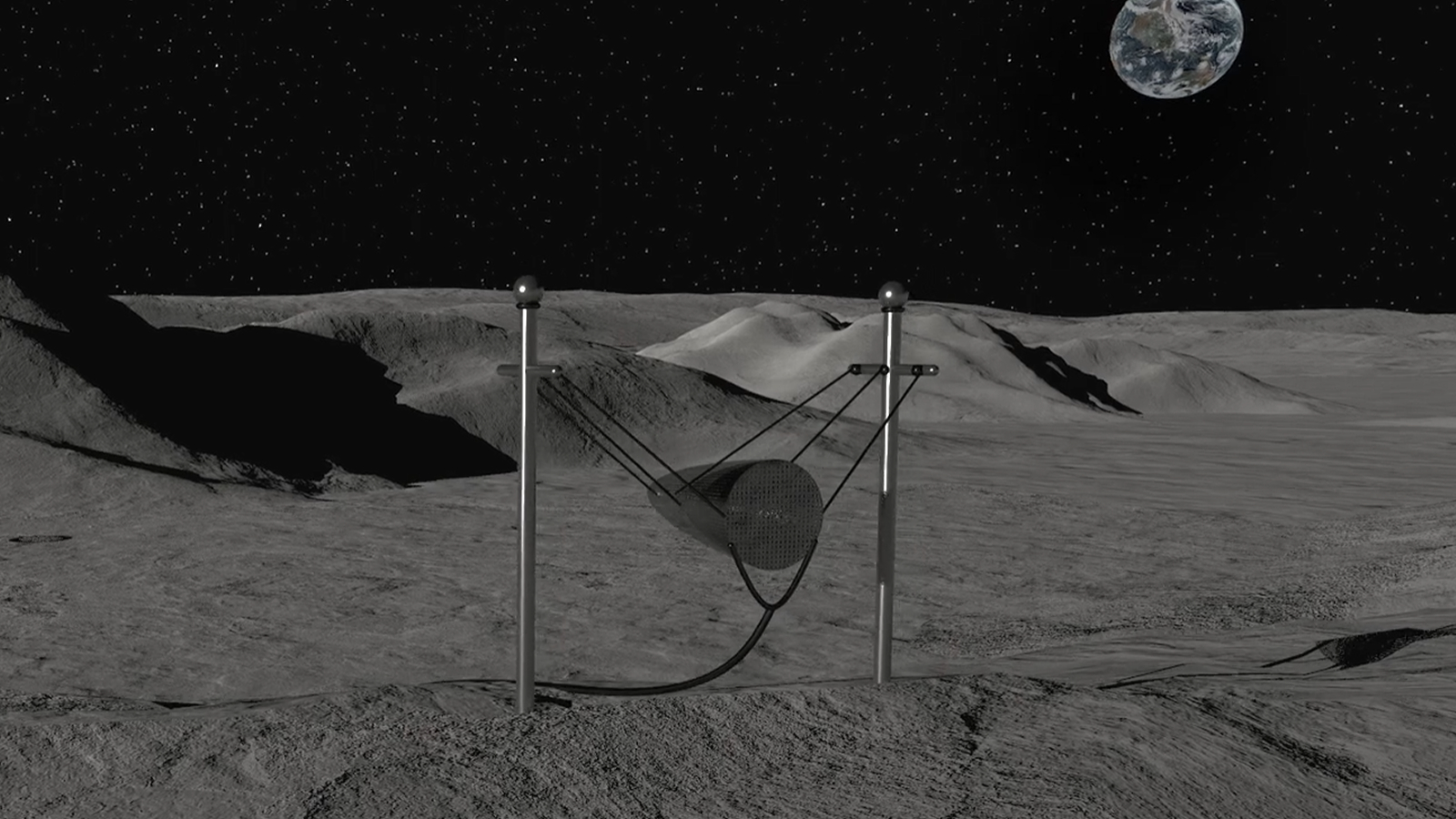An entrepreneur wants to build a giant net to catch spacecraft landing on the moon, but can it be done?
This novel idea could become an important piece of a future moon economy.

Greece-based entrepreneur has a unique idea for moon-bound deliveries: using a giant net to catch packages launched from lunar orbit. Although there are still many hurdles to clear, the system would address many of the key challenges for moon-bound deliveries and could aid in the future mining of lunar resources.
Right now, lunar landers are costly, especially when they fail. Rather than using landers for deliveries to the moon's surface, Charis Kosmas has developed a concept called the Momentum Absorption Catcher for Express Deliveries on Non-Atmospheric Somata (MACEDONAS).
It works like a butterfly net on bungee cords. "The Macedonian system consists of two elements: the catcher and the decelerator," Kosmas told Space.com. After the catcher intercepts the package, the attached decelerator slows the package until it reaches the landing pad.
With this idea, Kosmas wants to solve a few issues. When a lunar lander ascends to the surface of the moon, it uses rocket propulsion, which shoots up moon dust, or regolith. This highly abrasive dust can damage spacesuits, spacecraft and equipment. With MACEDONAS, regolith won't get kicked up during landing.
MACEDONAS is also economical, Kosmas said, because it doesn't use fuel. And because there's no fuel requirement, there's also no propulsion system, so MACEDONAS has more room for whatever is being delivered. "It will triple the efficiency," he said.
Rolling on the lunar surface
But MACEDONAS represents only the second stage in the lunar delivery system that Kosmas has envisioned with his company, Lunar Cargo. For the first step, a lunar orbiter would launch a giant wheel of wire at the moon. The wheel, called Oversized Payload Lander on Non-Atmospheric Somata (OPLONAS), would consist of flexible wire with a sealed cylinder tube at the wheel's center, which would hold a motor, batteries and cargo space.
OPLONAS would start out aboard an orbiter. "It will be launched in a package, in a storage form," Kosmas said. Then, using centrifugal force from the motor, "it will spin up when it arrives in low lunar orbit."
Breaking space news, the latest updates on rocket launches, skywatching events and more!
Upon landing, the wire wheel would flex with the moon's rough surface. "The outward forces will create a shielding against imperfections in the terrain," Kosmas explained. Then, OPLONAS would use the onboard motor to drive the delivery to its destination. "Being so large, it would be very efficient to roll without much friction," he added.
After the delivery, the sealed cylinder at the wheel's center could be flipped on its side and turned into a human habitat. "We need a lot of energy in order to spin up this structure, so we need batteries," Kosmas said. "These batteries will function now to protect the inhabitants of the habitat during the night."
The flexible wire from OPLONAS could then be upcycled to create most of the components needed to build MACEDONAS. "So, the concepts fit together in that sense," Kosmas said. "I like the idea of using simple material because it has many uses."
Making money on the moon
The lunar deliveries Kosmas envisions for MACEDONAS lie mostly in the future, as government agencies like NASA and the Defense Advanced Research Projects Agency (DARPA) are working with private companies to plan what an economy on the moon would look like.
Mining for resources will likely play an important role in this new economy. Aside from mining for lunar water, these efforts might involve the extraction of an isotope called helium-3, which is scarce on Earth but is in relatively large abundance on the moon.
If helium-3 can be mined and sent to Earth in a cost-effective way, it could become an important new energy source. Companies like U.S.-based Interlune and Japan-based ispace have already set their sights on helium-3 mining operations on the moon.
These mining operations would require heavy machinery. Kosmas wants mining companies like Interlune to use his delivery system to get their equipment to the moon. He said OPLONAS and MACEDONAS would be more efficient than lunar landers.
Kosmas' next step is to create a U.S. entity so he can apply for funding from U.S. agencies like NASA and DARPA. If he can secure funding and build the system, we might begin to see mining companies use giant butterfly nets to get their equipment to the moon's surface.
Kosmas will present his concept at the VivaTech event in Paris in June 2025.

Julian Dossett is a freelance writer living in Santa Fe, New Mexico. He primarily covers the rocket industry and space exploration and, in addition to science writing, contributes travel stories to New Mexico Magazine. In 2022 and 2024, his travel writing earned IRMA Awards. Previously, he worked as a staff writer at CNET. He graduated from Texas State University in San Marcos in 2011 with a B.A. in philosophy. He owns a large collection of sci-fi pulp magazines from the 1960s.
You must confirm your public display name before commenting
Please logout and then login again, you will then be prompted to enter your display name.
